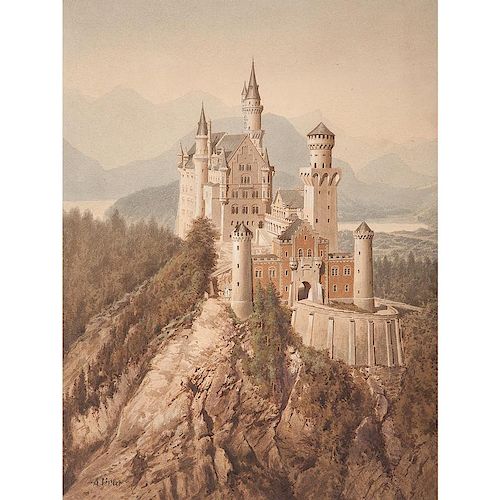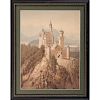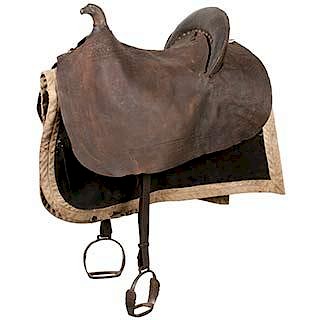Castle of Neuschwanstein, Bavaria Watercolor by Adolf Hitler
About Seller
6270 Este Ave.
Cincinnati , OH 45232
United States
With offices in Cincinnati, Cleveland and Denver, Cowan’s holds over 40 auctions each year, with annual sales exceeding $16M. We reach buyers around the globe, and take pride in our reputation for integrity, customer service and great results. A full-service house, Cowan’s Auctions specializes in Am...Read more
Two ways to bid:
- Leave a max absentee bid and the platform will bid on your behalf up to your maximum bid during the live auction.
- Bid live during the auction and your bids will be submitted real-time to the auctioneer.
Bid Increments
| Price | Bid Increment |
|---|---|
| $0 | $25 |
| $500 | $50 |
| $1,000 | $100 |
| $2,000 | $250 |
| $5,000 | $500 |
| $10,000 | $1,000 |
| $20,000 | $2,500 |
| $50,000 | $5,000 |
| $100,000 | $10,000 |
About Auction
Nov 1, 2017 - Nov 3, 2017
Cowan's Auctions dawnie@cowans.com
- Lot Description
Adolf Hitler (German, 1889-1945). Watercolor on paper board, signed l.l.; 23.5 x 15.5".
An accompanying letter of authenticity dated September 9, 1980 from Hitler expert Peter Jahn describes this watercolor in detail. Jahn recalls a conversation with the dictator regarding this particular work, as being the largest extant watercolor by Hitler.Fine rendering of the Castle of King Ludwig II of Bavaria - Schloss Neuschwanstein (New Swanstone Castle). This is a nineteenth-century Romanesque Revival palace. It was built by King Ludwig II as a devout homage to the great composer Richard Wagner, whom he practically worshipped. Therefore, it only follows that Adolf Hitler, who was also a devoted fan of the great Wagner would seek to honor him. It seems only logical, therefore, that New Swanstone Castle would be a natural for the young Hitler to paint at some time in his artistic career and his infatuation with Wagner would have enthused him to positively strain to make this fantastic watercolor one of his finest works.
The majesty of the castle as seen in Hitler’s painting is spellbinding and all who have seen it have praised it not only because it is Hitler’s work, but the painting itself emerges as a classic example of fine art of the Western world. Of all the watercolors painted by Hitler, this is one of the largest known. The only full and significant literary work dealing with Hitler’s paintings is titled Adolf Hitler: The Unknown Artist by Billy F. Price, and this painting is shown on page 181 of the book and is listed as plate number 6/100. Where it is shown it says it was painted in 1914 and it may have been among the last renderings he produced before enlisting in the Bavarian Army and going off to war. He still found some time to paint a few Munich scenes during that period.
Hitler’s architectural concepts were based upon his belief in “eternal values.” These values can be obviously perceived in his artistic works. These values contained mixed elements of classicism, the renaissance, and the baroque all of which were amalgamated in the “Vienna Ring Style." This monumental expression of the 19th-century imperial power may well have been the most significant architectural feeling generated in Hitler’s youth. He was acutely impressed with so many masterpieces of the building sciences as could be seen in Vienna such as the Burgtheater, the Votive Church, city hall, and Theophil von Hansen’s great Austrian Parliament building. Hitler knew these buildings down to their finest details and painted them repeatedly.
Peter Jahn of Vienna and Dr. August Priesack were considered the leading experts able to authenticate the paintings of Adolf Hitler. In 1935, the historical section of the NSDAP official archives in Munich was assigned the systematic task of locating and certifying the paintings of Adolf Hitler. Two archivists, Wilhelm Dammann and Dr. August Priesack, worked together and were responsible for authenticating all Hitler artwork that could be traced, purchased, or borrowed. The actual search for the art was carried out by staff members under the auspices of Hitler’s deputy Rudolf Hess.
Peter Jahn and Dr. Priesack were the last surviving experts in the NSDAP search for Hitler’s art. Jahn had many conversations with Hitler considering art in general, but particularly the Führer’s own art. With this painting of the castle there is an official letter of authenticity from Peter Jahn regarding this watercolor in detail. Jahn recalls a conversation with the Reich’s Chancellor himself regarding this particular work, as actually being the largest surviving watercolor by Hitler. The work is in fine condition and measures 23.5 x 15.5 inches. After the war, Jahn resumed his consulting career with no thoughts of his former activities on behalf of the Hess staff. When his name was mentioned in a magazine article in 1960, however, he received inquiries from all over the world and agreed to serve as personal advisor to the English Marquis of Bath when the latter began his large, personal collection.
Through his knowledge of Hitler’s Viennese style and subject matter and his numerous contacts in Vienna, Jahn has long been an authority on the subject and has traced and authenticated numerous paintings. His files and references were particularly useful to author Billy Price in writing his book on the subject Adolf Hitler: The Unknown Artist. Today, this book is one of the few works that covers the subject so thoroughly and interestingly. Both the paintings we acquired are shown in the book, but the Schloss Neuschwanstein canvas is unfortunately depicted in the noncolor section of the book; the St. Charles’s Church in winter, though, is shown in a large picture on page 49 of the Price book.
The watercolor was professionally framed under glass and matted. It was not examined out of the frame. The condition is overall very good. There is one arc-form scratch to the lower right corner of the watercolor, as well as a very small pin-hole size abrasion towards the lower left corner. A few small droplets of water paint can be found in the the upper right portion, and most likely happened during the the execution of the work. No creases or tears were detected. The frame has a few barely noticeable scratches on the sides.Condition
Eliminate the Hassle of Third-Party Shippers: Let Cowan's Ship Directly To You!
If you'd like a shipping estimate before the auction, contact Cowan's in-house shipping department at shipping@cowans.com or 513.871.1670 x219. - Shipping Info
-
Eliminate the Hassle of Third-Party Shippers: Let Cowan's Ship Directly To You!
If you'd like a shipping estimate before the auction, contact Cowan's in-house shipping department at shipping@cowans.com or 513.871.1670 x219.
At the request of the buyer, Cowan's will authorize the shipment of purchased items. Shipments usually occur within two weeks after payment has been received. Shipment is generally made via UPS Ground service. Unless buyer gives special instructions, the shipping method shall be at the sole discretion of Cowan's Auctions, Inc.. Cowan's is in no way responsible for the acts or omissions of independent handlers, packers or shippers of purchased items or for any loss, damage or delay from the packing or shipping of any property.
-
- Buyer's Premium



 EUR
EUR CAD
CAD AUD
AUD GBP
GBP MXN
MXN HKD
HKD CNY
CNY MYR
MYR SEK
SEK SGD
SGD CHF
CHF THB
THB












